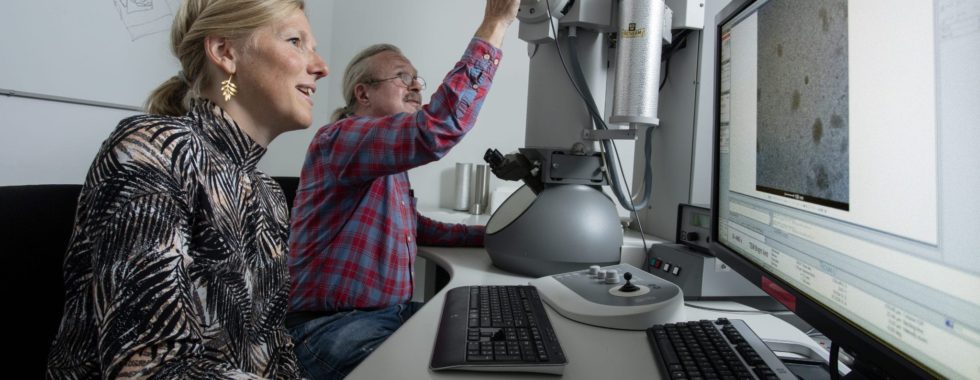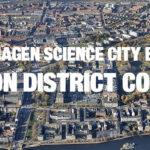Unique microscopy facility open for business
Cells and proteins. Drugs and DNA. Anything worth seeing in life science is worth magnifying. One of the world’s most versatile facilities for microscopy is located at the University of Copenhagen, Faculty of Health and Medical Science, in the heart of the innovation district Copenhagen Science city. It is now boosting its services to private companies in life science and related areas. By Jes Andersen.
The University of Copenhagen Core Facility for Integrated Microscopy (CFIM) does something that less than a handful of other global facilities do. They have placed light- and electron microscopy under the same leadership, and behind the same door. This gives users the option to choose the best technology for the task, without having to change venue.
Co-location an obvious advantage
The leader of CFIM is Professor MD Klaus Qvortrup. A man with an easy laugh, a rumpled shirt and worn jeans, you get the impression that he does not shy away from getting down and dirty with cables and laser sources. He sees the co-location of light and electron microscopy as an obvious advantage.
“We can work at all resolutions from cells to single molecules. On anything that is even remotely biological. In multiple dimensions. Because we have experts on all technologies working in the same group, we can provide a full service from experimental design over training, support and image analysis. From simple digitizing of histopathology slides to full-fledged research projects with animal subjects and all the trimmings” says Qvortrup, who initially conceived of the facility back in 2009.
Discretely open to industry
CFIM has never advertised the fact, but it has been open for industry users since its inception. One such is Ann-Louise Bergström, a Senior Research Scientist at Danish pharmaceutical company Lundbeck. In her quest for therapies against Parkinson’s disease, she has enjoyed access to staff and technology at CFIM almost from the day they opened.
“Lundbeck does not have an electron microscope, and even if we did, it would not be economically viable to keep staff and device continuously updated. I have been coming for six years because I know I get usable results here. CFIM has all the latest microscopes. I always feel I get the best advice on which methods to use and on how to prepare my samples optimally, and their full service support is kind and helpful. It’s not cheap, but definitely worth the money”, says Bergström.
Tommorows state of art
In just eight years, Qvortrup has built up CFIM from a single Scanning Electron Microscope to having what is arguably the strongest collection of magnification instruments on the planet. Calling a scientific instrument “State of the Art” is a hackneyed phrase and in the case of CFIM it doesn’t remotely do justice to their machine park.
CFIM is a so-called reference site for Leica, FEI and Carl Zeiss. These major microscope manufacturers send what will become tomorrow’s state of art-instruments to CFIM for testing and feedback. Asked about the capabilities of CFIM Qvortup shoots back:
“There is nothing in life science we cannot do”. He checks himself, laughs, and quickly amends: “There is not much in life science we cannot do”.
Talking through the options
With so many different technologies available, deciding which one to use can be daunting. Fortunately, staff at the Core Facility are happy to counsel users on the best strategy for all steps of the process. On sample preparation, on which instruments are most suitable for the task and on how to use the chosen instrument. Clara Prats, Head of Light Microscopy explains:
“We strongly advice our users to come and talk to us before they start a new project, to avoid what happens in too many cases, when the biological samples available are not usable or the chosen microscope is not the optimal for the task”, says Prats, and Ann-Louise Bergström concurs.
“I would counsel anyone to take advantage of their advisory service. Having a conversation about available technologies has helped me several times. And if you get a chance to join one of their courses or seminars… Jump to it”.
Heavy turnover ensures technological edge
Another reason for concentrating devices in one place is that any microscope becomes technically obsolete after about seven years. At any given time, CFIM services more than 600 life science researchers at University of Copenhagen faculties SCIENCE and HEALTH, at other universities, at university hospitals Rigshospitalet and Herlev and at a number of companies. Thanks to this unusually heavy turnover, they can keep adding to their collection of devices and keep training the staff for the next step. According to Ann-Louise Bergström this is pivotal to the value of CFIM.
“These technologies are difficult to master and expensive to update. I like the concept of collecting them all in one place. I am sure, that Lundbeck has gotten results out of CFIM, that in time will help our business,” concludes Ann-Louise Bergström.




